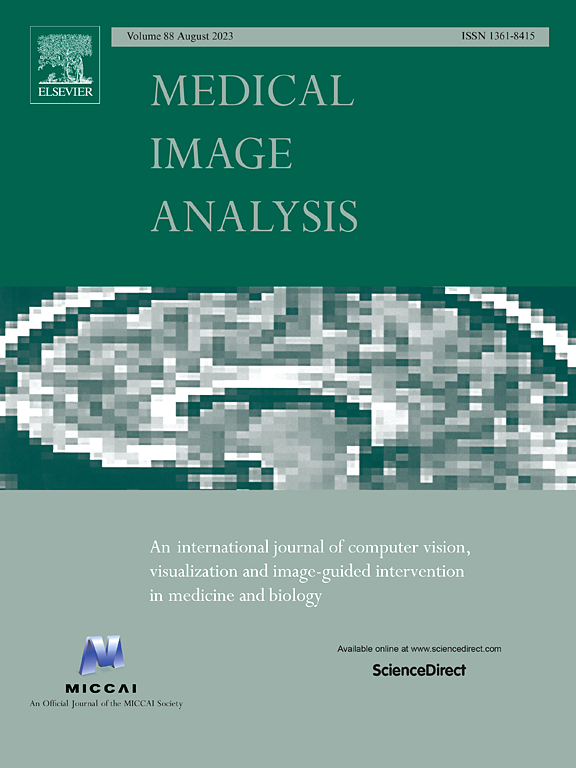Interpretable modality-specific and interactive graph convolutional network on brain functional and structural connectomes
IF 10.7
1区 医学
Q1 COMPUTER SCIENCE, ARTIFICIAL INTELLIGENCE
引用次数: 0
Abstract
Both brain functional connectivity (FC) and structural connectivity (SC) provide distinct neural mechanisms for cognition and neurological disease. In addition, interactions between SC and FC within distributed association regions are related to alterations in cognition or neurological diseases, considering the inherent linkage between neural function and structure. However, there is a scarcity of existing learning-based methods that leverage both modality-specific characteristics and high-order interactions between the two modalities for regression or classification. Hence, this study proposes an interpretable modality-specific and interactive graph convolutional network (MS-Inter-GCN) that incorporates modality-specific information, reflecting the unique neural mechanism for each modality, and structure–function interactions, capturing the underlying foundation provided by white-matter fiber tracts for high-level brain function. In MS-Inter-GCN, we generate modality-specific task-relevant embeddings separately from both FC and SC using a graph convolutional encoder–decoder module. Subsequently, we learn the interactive weights between corresponding regions of FC and SC, reflecting the coupling strength, by employing an interactive module on the embeddings of both modalities. A novel graph structure is constructed, which uses modality-specific task-relevant embeddings and inserts the interactive weights as edges connecting corresponding regions of two modalities, and then is used for the regression or classification task. Finally, a post-hoc explainable technology - GNNExplainer- is used to identify salient regions and connections of each modality as well as salient interactions between FC and SC associated with tasks. We apply the proposed framework to fluid cognition prediction, Parkinson’s disease (PD), Alzheimer’s disease (AD), and schizophrenia (SZ) classification. Experimental results demonstrate that our method outperforms the other ten state-of-the-art methods on multi-modal brain features on all tasks. The GNNExplainer identifies salient structural and functional regions and connections for fluid cognition, PD, AD, and SZ. It confirms that strong structure–function coupling within the executive and control networks, combined with weak coupling within the motor network, is associated with fluid cognition. Moreover, structure–function decoupling in specific brain regions serves as a marker for different diseases: decoupling of the prefrontal, superior parietal, and superior occipital cortices is a marker of PD; decoupling of the middle frontal and lateral parietal cortices, temporal pole, and subcortical regions is indicative of AD; and decoupling of the prefrontal, parietal, and temporal cortices, as well as the cerebellum, contributes to SZ.

脑功能和结构连接体的可解释模态特定和交互图卷积网络
脑功能连接(FC)和结构连接(SC)为认知和神经系统疾病提供了不同的神经机制。此外,考虑到神经功能和结构之间的内在联系,分布关联区域内SC和FC之间的相互作用与认知或神经疾病的改变有关。然而,现有的基于学习的方法缺乏利用特定于模态的特征和两种模态之间的高阶交互来进行回归或分类。因此,本研究提出了一个可解释的特定模态和交互的图形卷积网络(MS-Inter-GCN),该网络结合了特定模态信息,反映了每种模态的独特神经机制和结构-功能相互作用,捕捉了白质纤维束为高级脑功能提供的潜在基础。在MS-Inter-GCN中,我们使用图形卷积编码器-解码器模块分别从FC和SC生成特定于模态的任务相关嵌入。随后,我们通过在两种模态的嵌入上使用交互模块来学习FC和SC对应区域之间的交互权重,以反映耦合强度。构造了一种新的图结构,该图结构使用特定模态的任务相关嵌入,并将交互权值作为连接两个模态对应区域的边,然后用于回归或分类任务。最后,使用一种事后可解释技术- gnexplinterpreter -来识别每种模态的显著区域和连接,以及与任务相关的FC和SC之间的显著相互作用。我们将提出的框架应用于流体认知预测、帕金森病(PD)、阿尔茨海默病(AD)和精神分裂症(SZ)分类。实验结果表明,我们的方法在所有任务的多模态大脑特征上都优于其他十种最先进的方法。gninterpreter识别流体认知、PD、AD和SZ的显著结构和功能区域以及连接。它证实了执行和控制网络中的强结构-功能耦合以及运动网络中的弱耦合与流体认知有关。此外,大脑特定区域的结构-功能解耦可以作为不同疾病的标志:前额叶、顶叶上皮层和枕叶上皮层的解耦是PD的标志;中额叶和外侧顶叶皮质、颞极和皮层下区域的分离表明AD;前额叶、顶叶和颞叶皮质以及小脑的分离有助于SZ。
本文章由计算机程序翻译,如有差异,请以英文原文为准。
求助全文
约1分钟内获得全文
求助全文
来源期刊

Medical image analysis
工程技术-工程:生物医学
CiteScore
22.10
自引率
6.40%
发文量
309
审稿时长
6.6 months
期刊介绍:
Medical Image Analysis serves as a platform for sharing new research findings in the realm of medical and biological image analysis, with a focus on applications of computer vision, virtual reality, and robotics to biomedical imaging challenges. The journal prioritizes the publication of high-quality, original papers contributing to the fundamental science of processing, analyzing, and utilizing medical and biological images. It welcomes approaches utilizing biomedical image datasets across all spatial scales, from molecular/cellular imaging to tissue/organ imaging.
 求助内容:
求助内容: 应助结果提醒方式:
应助结果提醒方式:


